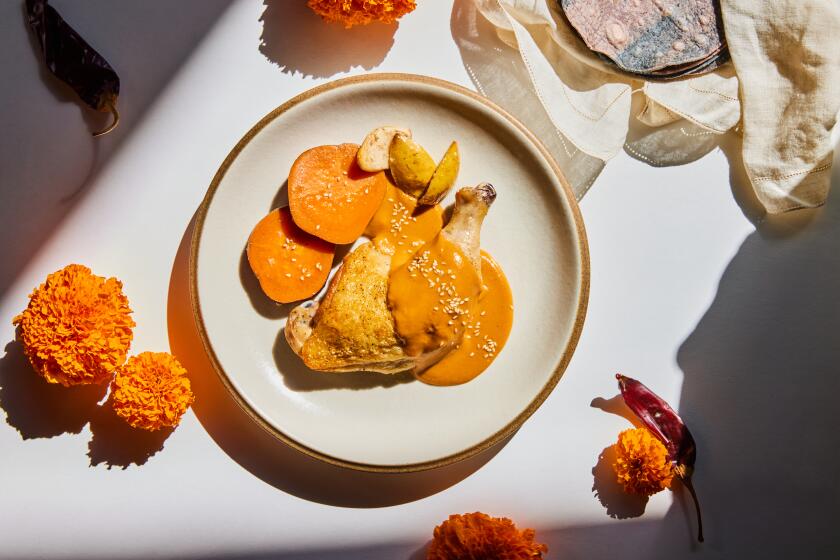Moshari yiouvetsi (veal and pasta casserole)
Greek cuisine, so often characterized here in L.A. as kind of, you know, “Mediterranean,” is a unique blend of ancient, Byzantine, Baltic, Turkish and Venetian influences.
And if you look a little more closely at some of Greece’s best loved dishes -- moussaka (eggplant and lamb casserole), pastitsio (pasta, cheese and meat casserole) and yiouvetsi (meat, orzo and tomato casserole), all seemingly homey baked melanges -- you’ll discover the descendants of noble, even royal dishes. Although they’re as easy to make as mac ‘n’ cheese, the complex, layered creations were originally served for Sunday dinners and special occasions.
Moussaka, almost a cliche as a Greek standard, is actually a relatively new “national” dish, arriving on the Greek mainland only in the 1920s. It was brought, during a time of political upheaval, by Greeks of the eastern regions whose cuisines had, for 2,000 years, been intertwined with the sophisticated, cosmopolitan cuisines of the people of the Byzantine and Ottoman empires. These Asia Minor Greeks were urban dwellers and knew French and Italian cooking techniques.
Made of eggplant slices layered with a sauce of ground lamb, it is traditionally topped with a bechamel sauce enriched with eggs. It’s a summer dish, made when eggplant is in season, and usually made the day before serving.
Martha Rose Schulman’s Balkan-style version lightens the topping, using a mixture of yogurt, eggs and kefalotiri cheese (a sheep’s- and goat’s-milk cheese), which is unique, but may be compared to pecorino instead of the traditional bechamel sauce. She also bakes the eggplant instead of frying it, as is traditional. The spicing of this and other moussakas -- cloves, cinnamon, allspice -- speaks of its Byzantine origins.
Yiouvetsi, a casserole of lamb, beef or veal with orzo and tomato, is named for the earthenware baking dish it was traditionally baked and served in.
“I remember my mother would prepare the yiouvetsi early Sunday morning,” recalls Cosmas Kapantzos, owner of Astro Burger on Melrose in Hollywood whose business is American hamburgers, but who makes yiouvetsi for family and friends at home. In Greece when he was growing up, he says, the whole family would drop off the unbaked yiouvetsi at the bakery or fournou on the way to church. “You would pay about five drachmas to have the casserole baked,” he says. “After church my sister and I would stop by the bakery to pick up the casserole and a loaf of fresh baked bread while my mother went home to start preparing lunch.”
A moshari yiouvetsi (veal and pasta casserole) inspired by Kapantzo’s recipe uses orzo, the rice-shaped pasta, and mizithra cheese, a sheep’s- or goat’s-milk cheese that adds a distinct salty flavor. The long baking results in fork-tender veal. White wine in the tomato sauce gives an added dimension, and a garnish of chopped green onion, parsley and mint adds a modern zing.
Like moussaka, pastitsio is a sweet-savory layered dish. Its name is derived from the Italian word pasticcio (hodgepodge), but its origins are with the grand molded timballos of Italy. It’s made with tubular pasta such as penne or elbow macaroni mixed with eggs and kefalotiri cheese. The meat sauce, spiced with cinnamon and cloves, is spread over the pasta and topped with a bechamel-kefalotiri sauce. Our version is adapted from a recipe used by Anne-Marie Olympios, a Belgian-born travel-tour leader whose husband is Greek and whose cooking reflects her international experience. Her use of butter is authentic to the regions of Greece where dairy products dominate and olive trees don’t grow.
Traditionally Greek dishes are served warm or at room temperature rather then hot out of the oven. Each of these casseroles should rest for at least 20 minutes after being removed from the oven to allow them to finish cooking and allow the flavors to blend.
It’s worth a trip to a Greek market for mizithra or kefalotiri cheese. While you’re there, pick up a bottle or two of Greek wine, bread, olives and some honey-sweetened pastry or cookies to serve with your casserole. Otherwise, all you need to accompany these rich one-dish meals is a simple salad: sliced romaine with chopped green onion, olive oil and vinegar, maybe, or a classic combination of sliced tomatoes, cucumber, red onion, Kalamata olives and oregano with an olive oil and vinegar dressing.
Then wish your guests “kali orexi!” -- good appetite!
Season the veal with 1 teaspoon salt and one-fourth teaspoon pepper. Brown the veal in several batches in 2 tablespoons olive oil in a large, heavy 5-quart pot, adding additional oil during browning if needed. As the meat browns, remove it from the pan and keep warm.
Add the onion to the drippings in the pan and saute until tender, about 2 minutes. Add the garlic and saute 1 to 2 more minutes.
Stir in the wine. Bring to a simmer and cook 1 minute. Stir in the strained tomatoes, 3 cups water and the veal stock.
Add the browned veal with any drippings back into the pot. Bring to a boil. Heat the oven to 350 degrees.
Add the remaining 2 teaspoons salt and one-half teaspoon pepper. Cover and bake 1 hour.
After an hour, add the orzo, stir to combine and bake about 25 to 45 minutes (depending on the pot used) or until most of the liquid is absorbed, stirring after 5 minutes and then stirring 3 or 4 more times during baking to prevent the orzo from clumping.
Remove the casserole from the oven and let stand 15 minutes. Sprinkle with the grated mizithra cheese.
In a small bowl, combine the chopped mint, parsley and green onion. Serve hot or at room temperature, passing the chopped herbs for sprinkling on top.
Get our Cooking newsletter.
Your roundup of inspiring recipes and kitchen tricks.
You may occasionally receive promotional content from the Los Angeles Times.















